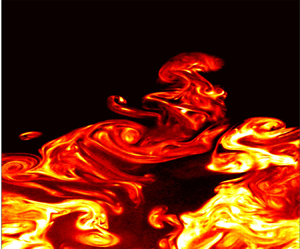Crossref Citations
This article has been cited by the following publications. This list is generated based on data provided by
Crossref.
Passaggia, Pierre-Yves
Mazellier, Nicolas
and
Kourta, Azeddine
2021.
Aerodynamic drag modification induced by free-stream turbulence effects on a simplified road vehicle.
Physics of Fluids,
Vol. 33,
Issue. 10,
Kankanwadi, Krishna S.
and
Buxton, Oliver R. H.
2021.
Progress in Turbulence IX.
Vol. 267,
Issue. ,
p.
13.
Nair, Vishnu
Heus, Thijs
and
van Reeuwijk, Maarten
2021.
A Lagrangian Study of Interfaces at the Edges of Cumulus Clouds.
Journal of the Atmospheric Sciences,
Vol. 78,
Issue. 8,
p.
2397.
van Reeuwijk, Maarten
Vassilicos, J. Christos
and
Craske, John
2021.
Unified description of turbulent entrainment.
Journal of Fluid Mechanics,
Vol. 908,
Issue. ,
Bempedelis, N.
and
Steiros, K.
2022.
Analytical all-induction state model for wind turbine wakes.
Physical Review Fluids,
Vol. 7,
Issue. 3,
Sahebjam, Rana
Kohan, Khashayar F.
and
Gaskin, Susan
2022.
The dynamics of an axisymmetric turbulent jet in ambient turbulence interpreted from the passive scalar field statistics.
Physics of Fluids,
Vol. 34,
Issue. 1,
Kohan, Khashayar F.
and
Gaskin, Susan J.
2022.
On the scalar turbulent/turbulent interface of axisymmetric jets.
Journal of Fluid Mechanics,
Vol. 950,
Issue. ,
Long, Yanguang
Wang, Jinjun
and
Pan, Chong
2022.
Universal modulations of large-scale motions on entrainment of turbulent boundary layers.
Journal of Fluid Mechanics,
Vol. 941,
Issue. ,
Kankanwadi, Krishna S.
and
Buxton, Oliver R.H.
2022.
On the physical nature of the turbulent/turbulent interface.
Journal of Fluid Mechanics,
Vol. 942,
Issue. ,
Bempedelis, Nikolaos
Laizet, Sylvain
and
Deskos, Georgios
2023.
Turbulent entrainment in finite-length wind farms.
Journal of Fluid Mechanics,
Vol. 955,
Issue. ,
Huang, Jingzi
Burridge, Henry C.
and
van Reeuwijk, Maarten
2023.
Local entrainment across a TNTI and a TTI in a turbulent forced fountain.
Journal of Fluid Mechanics,
Vol. 977,
Issue. ,
Huang, Jingzi
Burridge, Henry C.
and
van Reeuwijk, Maarten
2023.
The internal structure of forced fountains.
Journal of Fluid Mechanics,
Vol. 961,
Issue. ,
Buxton, Oliver R.H.
and
Chen, Jiangang
2023.
The relative efficiencies of the entrainment of mass, momentum and kinetic energy from a turbulent background.
Journal of Fluid Mechanics,
Vol. 977,
Issue. ,
Kohan, Khashayar F.
and
Gaskin, Susan J.
2023.
Scalar interfaces in the near field of a unity velocity ratio coaxial jet.
Physics of Fluids,
Vol. 35,
Issue. 3,
Kankanwadi, K. S.
and
Buxton, O. R. H.
2023.
Influence of freestream turbulence on the near-field growth of a turbulent cylinder wake: Turbulent entrainment and wake meandering.
Physical Review Fluids,
Vol. 8,
Issue. 3,
Vinnes, Magnus K.
Neunaber, Ingrid
Lykke, Hauk-Morten H.
and
Hearst, R. Jason
2023.
Characterizing porous disk wakes in different turbulent inflow conditions with higher-order statistics.
Experiments in Fluids,
Vol. 64,
Issue. 2,
Chen, Jiangang
and
Buxton, Oliver R.H.
2023.
Spatial evolution of the turbulent/turbulent interface geometry in a cylinder wake.
Journal of Fluid Mechanics,
Vol. 969,
Issue. ,
2023.
Turbulent/turbulent interfacial layers of a shearless turbulence mixing layer in temporally evolving grid turbulence.
Physics of Fluids,
Vol. 35,
Issue. 4,
Li, L.
and
Hearst, R. J.
2024.
Progress in Turbulence X.
Vol. 404,
Issue. ,
p.
125.
Shanmughan, Roshan
Passaggia, Pierre-Yves
Mazellier, Nicolas
and
Kourta, Azeddine
2024.
Coherent pressure and acceleration estimation from triply decomposed turbulent bluff-body wakes.
Experiments in Fluids,
Vol. 65,
Issue. 4,
